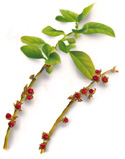| Latin Name | Withania somnifera Dunal (Solanaceae) |
| English Name | Winter cherry |
| Sanskrit Names | Ashvagandha, Hayahvaya, Vajigandha |
| Hindi Name | Asgandh |
 History: In Ayurveda, Asvagandha, which means "smelling like a horse or mare" in Sanskrit, is used as an aphrodisiac and geriatric tonic and indicated in rheumatism, cough, consumption, etc. The Greek physician Theophrastus, describes this plant, which is recorded in the Arabic ‘Kaknaj-el-manoum’. Rheede calls it ‘pevetti’ and states that a vulnerary ointment is prepared from the leaves. In the late 1880s, Dr. Trebut investigated its reputation for hypnotic properties. P.L. Simmonds (Amer. J. Pharm. Feb. 1891) states that the plant is used at the Civil Hospital, Alger, as a sedative and hypnotic. Distribution: Found throughout the drier parts of India in waste places and on bunds; also cultivated to a limited extent for the medicinal roots. Habit: W. s. is an erect, evergreen, tomentose shrub. The roots are stout, fleshy and whitish brown; the leaves are simple ovate, glabrous; the flowers are inconspicuous, greenish or lurid-yellow, in axillary, umbellate cymes; the berries are globose, orange-red when mature, enclosed in the persistent calyx and have yellow, reniform seeds. Principle constituents: Biochemically heterogeneous alkaloids including cuscohygrine, anahygrine, tropine, pseudotropine, anaferine. Indications: Aswagandha is used in asthma and as a uterine sedative. The total alkaloids showed relaxant and antispasmodic effects against several spasmogens on intestinal, uterine, bronchial, tracheal and blood-vascular muscles. Product range: Abana, Geriforte, Mentat, Tentex forte, Menotab, Antistress Tea |
|